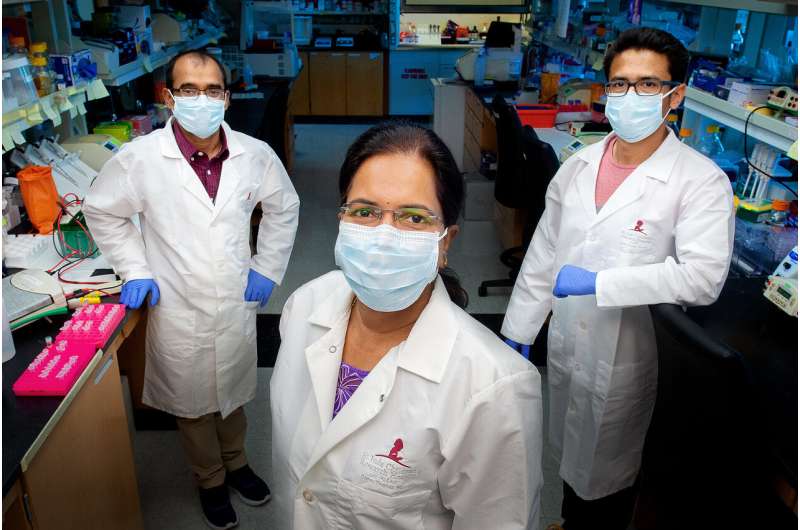Scientists identify possible COVID-19 treatment

The COVID-19 pandemic continues to cause significant illness and death while treatment options remain limited. St. Jude Children's Research Hospital scientists have discovered a potential strategy to prevent life-threatening inflammation, lung damage and organ failure in patients with COVID-19. The research appeared online in the journal Cell.
The scientists identified the drugs after discovering that the hyperinflammatory immune response associated with COVID-19 leads to tissue damage and multi-organ failure in mice by triggering inflammatory cell death pathways. The researchers detailed how the inflammatory cell death signaling pathway worked, which led to potential therapies to disrupt the process.
"Understanding the pathways and mechanism driving this inflammation is critical to develop effective treatment strategies," said corresponding author Thirumala-Devi Kanneganti, Ph.D., vice chair of the St. Jude Department of Immunology. "This research provides that understanding. We also identified the specific cytokines that activate inflammatory cell death pathways and have considerable potential for treatment of COVID-19 and other highly fatal diseases, including sepsis."
COVID-19, cytokines, and inflammatory cell death
COVID-19 is caused by the SARS-CoV-2 virus. The infection has killed more than 1.2 million people in less than one year and sickened millions more.
The infection is marked by increased blood levels of multiple cytokines. These small proteins are secreted primarily by immune cells to ensure a rapid response to restrict the virus. Some cytokines also trigger inflammation.
The phrase cytokine storm has been used to describe the dramatically elevated cytokine levels in the blood and other immune changes that have also been observed in COVID-19, sepsis and inflammatory disorders such as hemophagocytic lymphohistiocytosis (HLH). But the specific pathways that initiate the cytokine storm and the subsequent inflammation, lung damage and organ failure in COVID-19 and the other disorders was unclear. The cellular and molecular mechanisms that comprehensively define cytokine storm was also lacking.
Kanneganti's team focused on a select set of the most elevated cytokines in COVID-19 patients. The scientists showed that no single cytokine induced cell death in innate immune cells.
The St. Jude investigators then tried 28 cytokine combinations and found just one duo that, working together, induced a form of inflammatory cell death previously described by Kanneganti as PANoptosis. The cytokines are tumor necrosis factor (TNF)-alpha and interferon (IFN)-gamma. PANoptosis is a unique type of cell death that features coordination of three different cell death pathways—pyroptosis, apoptosis and necroptosis. PANoptosis fuels inflammation through cell death, resulting in the release of more cytokines and inflammatory molecules.
The investigators showed that blocking individual cell death pathways was ineffective in stopping cell death caused by TNF-alpha and IFN-gamma. A closer look at proteins that make up the pathways identified several, including caspase-8 and STAT1, that were essential for PANoptosis in response to these cytokines. Deleting those proteins blocked PANoptosis in innate immune cells called macrophages.
Potential for repurposing TNF-alpha and IFN-gamma blockers to treat COVID-19
Because TNF-alpha and IFN-gamma are produced during COVID-19 and cause inflammatory cell death, the investigators questioned whether these cytokines were responsible for the clinical manifestations and deadly effects of the disease. They found that the TNF-alpha and IFN-gamma combination triggered tissue damage and inflammation that mirror the symptoms of COVID-19 along with rapid death.
Neutralizing antibodies against TNF-alpha and IFN-gamma are currently used to treat inflammatory diseases in the clinic. The investigators found that treatment with these antibodies protected mice from death associated with SARS-CoV-2 infection, sepsis, HLH and cytokine shock.
"The findings link inflammatory cell death induced by TNF-alpha and IFN-gamma to COVID-19," Kanneganti said. "The results also suggest that therapies that target this cytokine combination are candidates for rapid clinical trials for treatment of not only COVID-19, but several other often fatal disorders associated with cytokine storm."
Added co-first author Rajendra Karki, Ph.D., a scientist in the Kanneganti laboratory: "We were excited to connect these dots to understand how TNF-alpha and IFN-gamma trigger PANoptosis." Co-first author Bhesh Raj Sharma, Ph.D., a scientist in the Kanneganti laboratory, added: "Indeed, understanding how PANoptosis contributes to disease and mortality is critical for identifying therapies."
Redefining cytokine storm
Based on this fundamental research, Kanneganti and her colleagues have proposed a definition of cytokine storm that puts the cytokine-mediated inflammatory cell death via PANoptosis at the center of the process. The researchers noted that PANoptosis results in the release of more cytokines and inflammatory molecules, which intensifies systemic inflammation.
"We have solved a major piece of the cytokine storm mystery by characterizing critical factors responsible for initiating this process, and thereby identifying a unique combination therapy using existing drugs that can be applied in the clinic to save lives," Kanneganti said.
More information: Rajendra Karki et al, Synergism of TNF-α and IFN-γ triggers inflammatory cell death, tissue damage, and mortality in SARS-CoV-2 infection and cytokine shock syndromes, Cell (2020). DOI: 10.1016/j.cell.2020.11.025



















